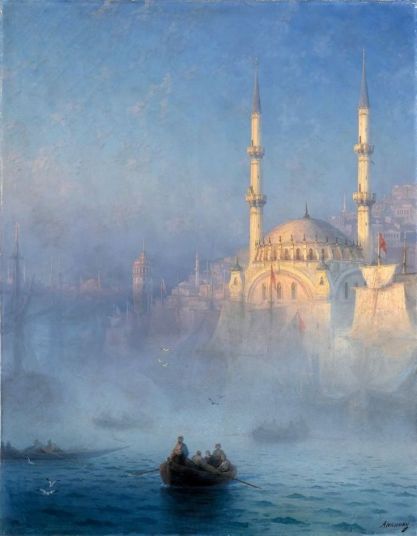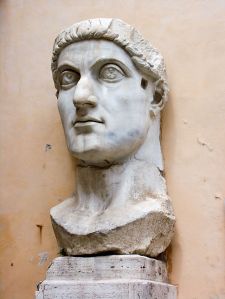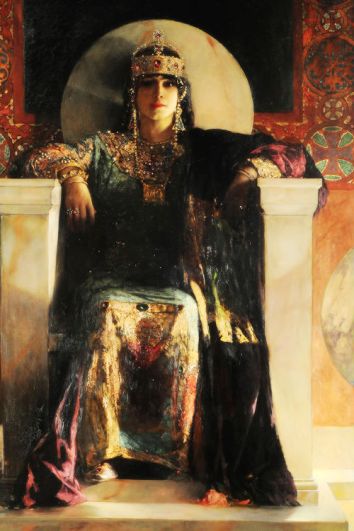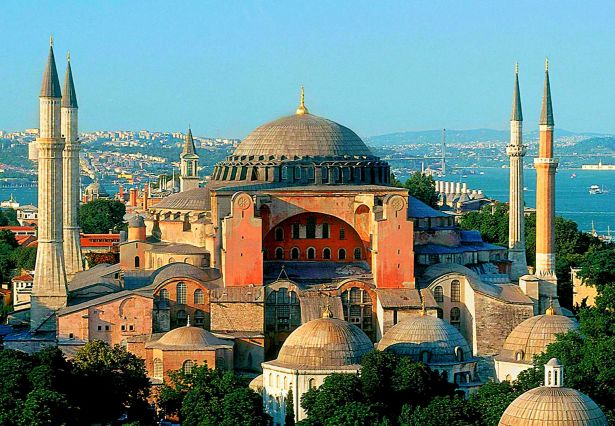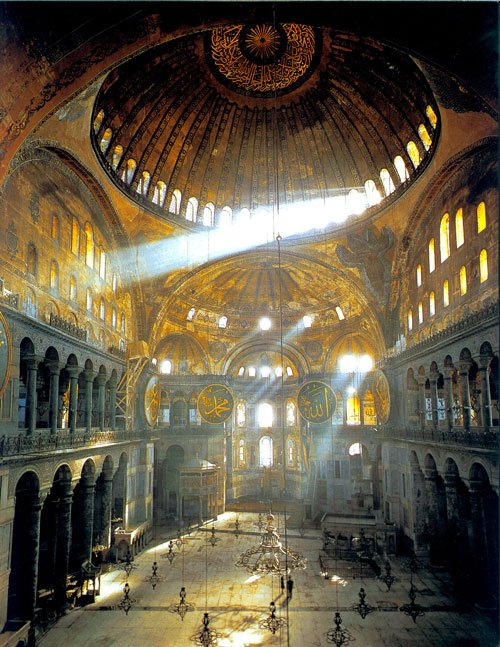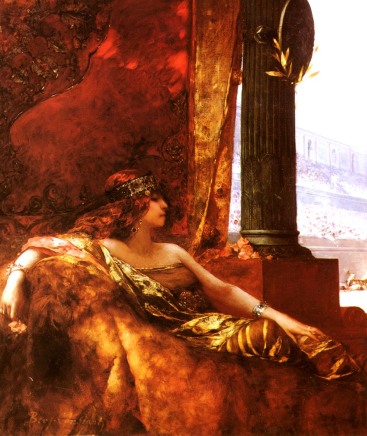.
“One’s not half of two; two are halves of one.”
― E.E. Cummings
.
Why write about an Emperor and Empress who ruled a forgotten empire 1500 years ago?
Sure, they lived around 500 AD in what is now Istanbul, Turkey. They spoke the dead languages of ancient Greek and Latin. Most of us have a hard time even pronouncing “byzantine” (biz-an-teen). But I like to think that Theodora and Justinian have more to teach us than we might realize.
As I explained in my last post, they lived something close to a fairy tale – two ordinary kids from the lowest social classes one day found themselves Emperor and Empress of the Byzantine Empire. Yet the story of Justinian and Theodora endures beyond their rise and flows into their reign: one that defined their empire for nearly 1000 years, and still stands as one of the greatest examples of a power couple at work in history.
And I’ll be the first to admit it: I am a huge fan of Theodora.
Let me back up a little bit and give you a sense of what this very strange Byzantine Empire was.
It was a Monday
Back around 300 AD, the Roman Emperor Constantine decided he was tired of the old gods and converted to Christianity. He was the very first Christian emperor, and he converted the empire with him, sanctioning it as the state religion. Not everyone was very impressed.
It’s kind of ironic today, but back in the day, the capital city Rome didn’t want to convert. It loved its pagan ways too dearly! Eventually, Constantine threw his hands in the air in disgust and decided that if the capital wouldn’t have a new religion, Constantine would have a new capital.
He looked across his empire to the chic and sophisticated east and spotted a peninsula sporting a neat looking city called Byzantium. Constantine fell in love, set up shop, and renamed it Constantinople after the best looking guy in town – himself. It was sanctioned the new capital of the Roman Empire on 11 May 330. It was a Monday.
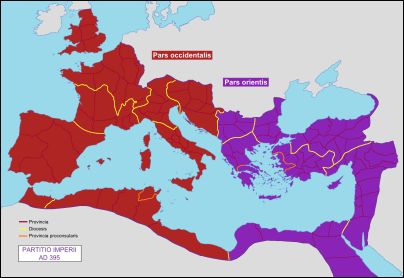
Roman Empire: red was conquered by various barbaric tribes, purple was the inherited empire of Justinian and Theodora.
Well, over the course of the next couple hundred years, the western end of the empire fell prey to hoards of marauding barbarians that took possession of what is now North Africa, England, Spain, France, and Italy (in a ploy to seem more important than they were, the barbarians who took control of the Italian peninsula put a capital in Ravenna and called themselves the “Roman Empire”…all 20 miles of it. Nice try, guys).
But Constantinople grew in importance and grandeur until it was the largest city in the world, the dynamic center of a thriving empire. People from all over the world came to Constantinople – to work their way up the social ladder, to enjoy the pleasures of the empire, to seek the protection of their awesome wall that kept invaders out for almost 1000 years (until some epic Game of Thrones-level treachery went down in 1204 and the city was sacked by allies…yeah, that was a weird time). It was said that you could hear all 72 known languages of the world spoken within the city.
The empire was Roman, but at the same time it wasn’t. For one thing, it was fundamentally Christian (the politics were even religious – people got into fist fights about whether Jesus was divine incarnate, or if he became divine post-resurrection). For another, most of the people spoke Greek. Nevertheless, peeps in the empire still called themselves ‘Romans’ and looked upon the barbarian-occupied west as a sad loss.
Game-Changers
Enter Justinian and Theodora, newly-made Emperor and Empress. They were quite the magnificent product of the strange and wonderful Constantinople, and they immediately kicked into gear to make their empire all the more magnificent.
First things first, Justinian named his wife Theodora as co-regent, meaning she had equal power and authority with her husband and could use it. And boy did Theodora use it.
My girl Theodora was not about to forget her past in the red light districts of the capital (and elsewhere). As empress, she shut down forced prostitution rings and brothels, established a convent for ex-prostitutes seeking rehabilitation, and instituted the death penalty for rape (unheard of in Rome).
But she wasn’t about to stop there. Theodora enacted laws expanding women’s rights of divorce and property ownership, forbidding the killing of a wife for adultery, granting mothers some rights over their children, and prohibiting abandonment of unwanted infants. She singlehandedly improved the lives of women in the empire through her unprecedented position as co-regent.
But Theodora in no way limited herself – she treated with foreign dignitaries and sent orders to officers in the field. She was Justinian’s chief counselor – whenever he came up with some new plan or design for the empire, Theodora was the first person he turned to to discuss his ideas. They were a first-class dream team.
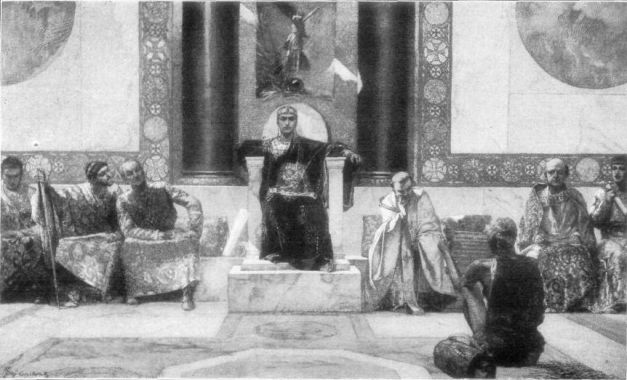 For his part, Justinian believed that he had been chosen to do God’s will as emperor over a Christianized Roman Empire. Therefore, he took his job very seriously. In fact, he was nicknamed the “Night’s Emperor” because he was known to work through day and night, sleeping only a little, in order to see projects to completion.
For his part, Justinian believed that he had been chosen to do God’s will as emperor over a Christianized Roman Empire. Therefore, he took his job very seriously. In fact, he was nicknamed the “Night’s Emperor” because he was known to work through day and night, sleeping only a little, in order to see projects to completion.
Let’s just say his little projects were quite ambitious. For instance:
-
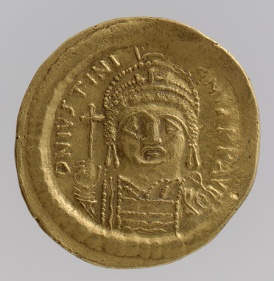
Justinian was the first emperor to have his image face-forward instead of in profile, the standard for all imperial coins after.
Justinian undertook the task to revise and codify over 1000 years of Roman law (a masterpiece which became the standard for Europe, and is still studied today).
- He started a massive infrastructure campaign, building bridges and modernizing roads.
- By the end of his reign, he had built some 25 churches, including the crown jewel, the Hagia Sophia (more on that later)
- He kickstarted a reconquest of the lost western territories in an effort to restore the ancient glory of Rome at its height.
All these enterprises understandably stretched the treasury to its breaking point, and so Justinian hired some very capable financial advisors who quickly raised the necessary funds through taxation.
This was – shall we say – an unpopular move.
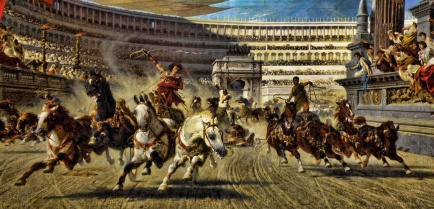
Chariot races at the hippodrome: think Ben Hur + political forum + religious zealots + super bowl drunks.
The Nika Riots
Only 5 years into Justinian and Theodora’s reign, people had had enough. Seven dudes decided they were going to do something about it, and started a sort of epic-shouting match at the Hippodrome (the enormous arena built to seat nearly the entire city’s population) to let Justinian know how how unpopular his taxes were. Things got out of hand and turned deadly, and the emperor ordered the arrest and execution of the agitators to make an example. But when the executions were botched and two men escaped into hiding by the crowds, tensions escalated.
At the next chariot race, the two political factions of the city unexpectedly united in protest against Justinian, demanding the pardon of the convicted, screaming “NIKA! NIKA! NIKA!” (meaning “win” in greek). It would be like if tea partiers united with democrats on a common platform – the emperor was justifiably scared. The chariot races for the day were cancelled, but the damage was already done – the crowd stormed from the stadium and commenced burning the city to the ground.
For a solid week, crowds continued to riot and burn down Constantinople. They demanded the pardon of the 2 escaped rabble-rousers. Justinian granted it. They demanded that the emperor fire his financial advisors. He did so. Nothing stopped them – the people continued to grow more violent and frenzied.
After 5 days of citizens murdering, vandalizing, and attempting to break into the palace, Justinian’s remaining advisors convinced him to abandon the capital and flee to save his life. He ordered the ships to be readied, and was ready to depart with his wife out a back door, knowing that leaving the city meant giving up his status as emperor.
Theodora, however, would not back down so easily. She stood before her husband and the men of his council and gave one of the most hardcore speeches of all time:
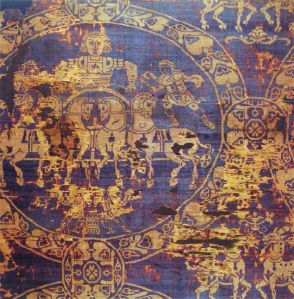
Legit royal shroud from Constantinople: “May I never be without the purple I wear…purple is the noblest shroud.” – Theodora
“I do not care whether or not it is proper for a woman to give brave counsel to frightened men; but in moments of extreme danger, conscience is the only guide. Every man who is born into the light of day must sooner or later die; but how can an Emperor ever allow himself to become a fugitive. … [C]onsider first whether, when you reach safety, you will not regret that you did not choose death in preference. As for me, I stand by the ancient saying: royalty makes the best shroud.”
With these words, Empress Theodora convinced an emperor and his council to remain, thereby preserving their nearly-lost reign. With courage inspired by his wife, Justinian devised a plan to end the riots once and for all.
He sent his foremost general Belisarius and his troops to meet the people of the city in the hippodrome where they were camped. Once the soldiers were in place, the exits were sealed and the signal was given – soldiers fell upon citizens, killing indiscriminately. About 30,000 were killed. The riots ended that afternoon.
The Nika Riots lasted over 5 days and 5 nights. Over half the city was in ashes, including some of the most important churches and thousands of homes. Justinian’s act was decisive in ending the riots, if cruel. Personally, I don’t know what else he could have done to end the riots, but that doesn’t mean I have to be okay with what he did.
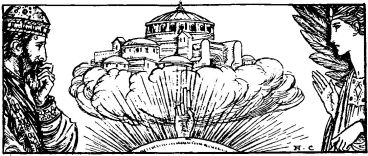 Hagia Sophia
Hagia Sophia
After the riots, Constantinople was a straight-up mess, so Theodora and Justinian made plans to rebuild. The ensuing years would see wonder after wonder rise in the city as works of art in stone came to dominate the landscape.
But absolutely nothing outdid Justinian’s baby, the grand cathedral – Hagia Sophia (pronounced HAH-yuh so-FEE-uh, meaning “Holy Wisdom”).
The magnificent church had been built by Constantine when he first established Constantinople, but it had burned down in the inferno of the Nika riots. Justinian, being who he was, saw opportunity in the loss, and envisioned a church grander than any had yet dared construct.
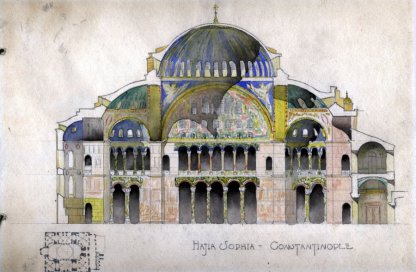 With ambitions about as high as they could go, Justinian hired two mathematicians instead of architects to engineer an out-of-this world design. They delivered.
With ambitions about as high as they could go, Justinian hired two mathematicians instead of architects to engineer an out-of-this world design. They delivered.
To this day, the Hagia Sophia is a wonder to behold. It continues to dominate the Istanbul skyline the same as it did 1500 years ago at its construction. For 1000 years it was the largest cathedral in the world.
The dome alone was enough to make it absolutely revolutionary. It is 108 feet in diameter, and rises 180 feet off the ground – a remarkable feat, especially considering that it is a construction made entirely without steel.
And it only took them 5 years to build (532-537 AD). Now that’s what I call impressive.
When Justinian entered the finished the cathedral for the first time, he was known to have said, “Solomon, I have outdone thee!”
In 1453, Constantinople was conquered by the Ottomans and the Hagia Sophia was converted from an Eastern Orthodox cathedral to a mosque, which it remains to this day. But it is no less magnificent for it. Scholars and art aficionados alike acclaim it as one of the greatest things to come from the Byzantine Empire, and possibly the best thing to come out of Justinian’s reign.
End of an Era
11 years after the completion of the Hagia Sophia, Theodora passed away of cancer on 28 June 548. She was in her 40s.
Justinian, consumed with grief, locked himself in the palace and refused to see anyone for a period of time. The entire city mourned with him. Theodora had been a remarkable woman and a remarkable empress – one who used her power to serve the empire and improve lives where she could.
Many didn’t know what to make of her – a woman from very humble origins who had risen above them all to rule and reign. Beautiful, terrifying, witty, graceful, smart, brave, proud, delightful, sexy – everyone had something different to say about Theodora. She had been all of these things – and more – and the empire was the less for her passing.
Justinian would outlive her by 17 years. He did end up fulfilling his dream of bringing the western territories back into the empire. But without Theodora, the light of his life, he was an engine running on one cylinder. On his own he was a good ruler, but with her he had been a phenomenal ruler.
People like Justinian and Theodora should never be forgotten. We hardly hear of the Byzantine empire at school, and still less of the people who lived there. But this couple is important not necessarily because of how they shaped history (though they certainly did that) but because of what intense figures they themselves were.
I mean, how awesome is it that some random peasant farmer from Middle of Nowhere, Europe and an urban-raised stripper managed to find each other in the world’s biggest city and come to dominate that city and the empire? Each of them individually would have been an interesting study – but together, they were one of history’s greatest romances and power couples.
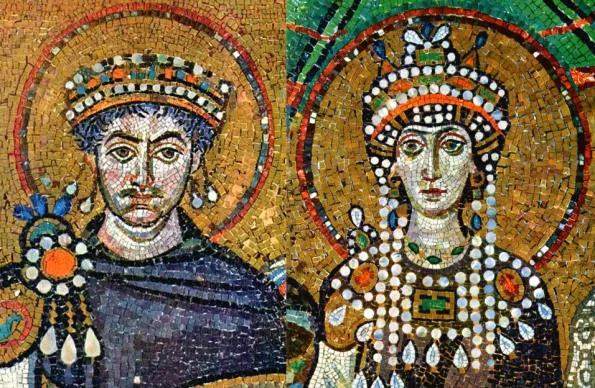
Mosaics from a church in Ravenna, Italy: Justinian on one wall faces Theodora opposite him – how romantic.
And they rocked it.
Sources:
Browning, Robert. Justinian & Theodora. 1971.
Norwich, John Julius. A Short History of Byzantium. 1997.
More on the Nika Riots: Smithsonian Magazine; University of Chicago.
Hagia Sophia facts.
They are starting to put ads on our blog. We do not approve these and are not getting any residuals whatsoever, so I apologize for the content. I’ll see what I can do about it.
